Technologies for production of construction materials and products. Рубрика в журнале - Nanotechnologies in Construction: A Scientific Internet-Journal
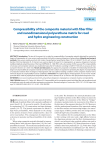
Статья научная
Introduction. The aim of the research is to study the compressibility of composite materials obtained by varying the degree of impregnation of a non-woven needle-punched cloth with an aqueous dispersion of polyurethane. Materials and research methods. Non-woven needle-punched cloth made of polyethylene terephthalate fibers (TU 6-13-0204077-95-91) with a linear density of 0.33 tex (diameter 20–25 microns) was used as objects of research. For impregnation, an aqueous dispersion of anionic stabilized aliphatic polyethiruretane of the brand IMPRANIL DL 1380 (PRC) with a dry residue of 40% was used. The compressibility of canvases and composite materials was established using the ICH indicator according to GOST 577-68 with an accuracy of measuring the thickness of ± 0.001 mm. Results and discussion. An approach is proposed to establish the relationship between the degree of compressibility of composite materials and the load and to obtain an equation for predicting the degree of compressibility of composite materials from the degree of impregnation and load. Optimal loading conditions of the composite material with a minimum degree of compressibility has been established. Conclusion. The optimal degree of impregnation of a non-woven needlepunched fabric made of polyethylene terephthalate fibers with a diameter of 20–25 microns with polyurethane dispersion is 0.5.
Бесплатно
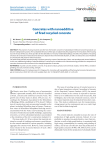
Concretes with nanoadditive of fired recycled concrete
Статья научная
The practice of using recycled concrete from the broken concrete of substandard reinforced concrete products can become widespread in practice. The undoubted relevance of this topic is explained by the program for the renovation of the housing stock in the city of Moscow, which provides for the demolition of 5-storey residential buildings until 2032. The problem of recycling and reuse of construction waste becomes obvious to improve the environmental situation, as well as to reduce the cost of materials in construction and preserve natural resources. The article deals with the nanostructuring of cement systems by means of introduction of ultra- and nanodispersed mineral additives. In this case, additional grinding of mineral additives is carried out in cavitation units. Nanostructuring provides the compaction of concrete structures and an increase in the strength properties of concrete.
Бесплатно
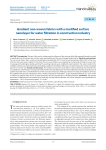
Статья научная
Introduction. The aim of the work is to determine the influence of the structure of the filter materials formed as a result of modification of the surface layer on their water permeability and the size of trapped solid particles. Materials and methods. The non-woven fabrics from a mixture of polyethylene-terephthalate (PET) (70 wt.%) and bicomponent fibers (BCF) of the coreshell structure were used as objects of the study. The non-woven fabrics were obtained by mechanically forming the canvas with its subsequent hardening by needle punching. The resulting materials were modified by heat treatment. The water transfer in the modified materials was determined by the permeability coefficient. The filtration efficiency was determined by the number of trapped particles of a certain size. Results and discussion. The needle-punched non-woven fabrics without additional heat treatment are not suitable for water filtration. The proposed method of thermal and deformation-thermal modification provides the production of gradient materials with a controlled thickness of the nanoscale surface layer. Although a decrease in water permeability is observed, the modified material traps solid particles with a smaller (compared to unmodified ~ 20 μm) equivalent diameter of 2–4 μm, which is sufficient to prepare water for use in steam generators and in the production of building materials. Conclusion. The optimal parameters of deformation-heat treatment for obtaining the high-effective filtration non-woven materials were established: the temperature – 180оC, the processing speed – 3.5 m/min.
Бесплатно
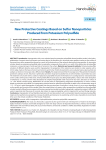
New Protective Coatings Based on Sulfur Nanoparticles Produced from Potassium Polysulfide
Статья научная
Introduction. Impregnation with a new solution based on potassium polysulfide showed excellent results in the hydrophobization of cement stone and cement-sand mortar due to the formation of a nanoscale water-repellent coating on the surface of the pores from sulfur nanoparticles formed as a result of the destruction of the molecule during the drying process. An innovative solution based on potassium polysulfide refers to polysulfur compounds, from which, as a result of the destruction of polysulfide molecules, a nanoscale layer of sulfur particles is formed on the surface. Materials and research methods. Potassium polysulfide solutions of different densities were used for impregnation; the properties of the solutions were tested on cubic samples with a 40 mm edge, made on the basis of cement and cement-sand mortar. Particle characteristics were evaluated using a laser particle size analyzer, an electron microscope and a diffractometer. Results. The analysis showed that the average size of the particles forming the protective coating is 20 nm, they have a spherically symmetric shape and crystallize into an orthorhombic crystal lattice structure. The treatment of concrete with a solution of potassium polysulfide ensures the formation of a coating based on nanosized sulfur on the surface of the pores of the stone, which partially fills the pore space and, being hydrophobic, reduces the water absorption of samples by 2–3 times, and the water absorption of samples impregnated under vacuum for 0.5 hours, decreases to values of 1.3–1.9%. Results and discussion. Modification of concrete with an impregnating composition developed by us with a solution based on potassium polysulfide The impregnating solution based on potassium polysulfide is stable in the concentration range of 1.15–1.35 g/cm3; upon impregnation, it penetrates into the pore structure of concrete at a level of up to 4 cm or more, depending on the growth and structure of the sample. When the material dries in its pores, sulfur nanoparticles crystallize from the polysulfide solution, partially filling the pore space and forming a protective durable insoluble hydrophobic coating that makes it difficult for water to penetrate into the pores of concrete, but retains its vapor permeability, which is important for wall and facing materials. Conclusions. Impregnation of road building materials and concrete products with a composition based on potassium polysulfide improves their performance properties, increases durability and resistance to weathering, which makes it possible to recommend it for use in the climatic conditions of the Russian Federation.
Бесплатно
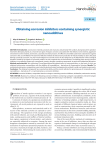
Obtaining corrosion inhibitors containing synergistic nanoadditives
Статья научная
Introduction. Construction materials, products and structures, and primarily their surfaces, during long-term operation have been destroying mainly as a result of two types of impact: corrosive, associated with the influence of an external, aggressive environment on the material, and erosive, caused by mechanical action. An effective and widely used means of protection against corrosion is the use of inhibitors The search for effective methods of anticorrosion protection of metals and alloys is due to the great damage caused by corrosion, not only in technological or economic terms. No less dangerous is the deterioration of the ecological situation caused by the ingress of corrosion products or toxic reagents into the environment. The leading place among corrosion inhibitors is occupied by heterocyclic compounds, namely, nitrogen-containing compounds, in particular imidazoline derivatives. Methods and materials. We synthesized 2-amylidenehydrazinoimidazolinone-4n aminoguanidine, on the basis of which we obtained anticorrosion compositions with the addition of nanoadditives – derivatives of unsymmetrical triazines. Results. The synthesized anticorrosive compositions were tested by electrochemical and gravimetric methods in acidic and model environments. Conclusion. The obtained compounds have a protective ability, and the results indicate the promising use of compositions with nanoadditives – derivatives of 1,2,4-aminotriazines as corrosion inhibitors.
Бесплатно

